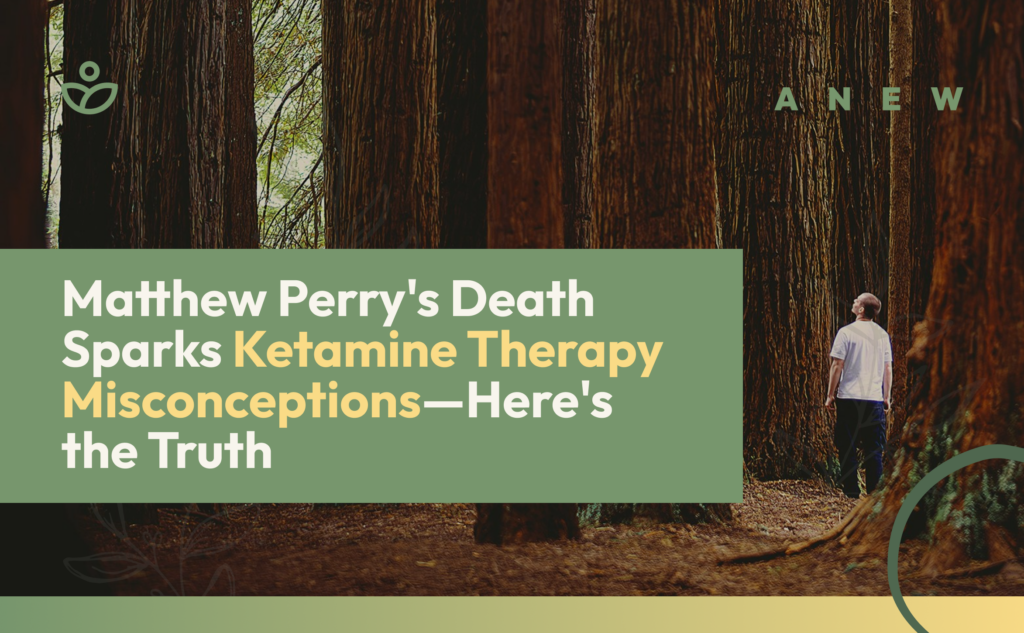Introduction
The death of beloved actor Matthew Perry has left many in shock and mourning. While his loss is a personal tragedy, it also sparked widespread misinformation, particularly surrounding ketamine therapy—a treatment Perry had openly supported for mental health.
This week, Anew Therapy’s podcast hosts Ashlynn and Dr. Gilmore discussed the Matthew Perry case and how it has led to misconceptions about ketamine therapy in general. In Ashlynn’s words: “The goal for today is to walk through the official reports of what occurred… and unpack ketamine’s role in all of this.”
Understanding the Official Autopsy Report
The official autopsy report of Matthew Perry listed multiple contributing factors to his death, including drowning, heart disease, and ketamine. Perry was found in his spa, and the toxicology report revealed ketamine levels far above the therapeutic levels typically used in clinical settings. Dr. Gilmore explained, “He had enough ketamine in his bloodstream when he passed away, that he could have been under general anesthesia.”

Ashlynn and Dr. Gilmore continued to discuss how context is crucial in this case. “It was multiple things contributing to his death in that circumstance, and not just one thing”, said Dr. Gilmore. Unsupervised use in a hazardous environment, like a spa, was a serious issue. Gilmore emphasized, “I hate to blame it on the pool, but I really think with Matthew Perry’s situation, the pool was a huge contributor.“
The Safe Use of Ketamine in Therapy
Ketamine therapy is a valuable and life-changing treatment for individuals suffering from severe depression, anxiety, and substance abuse disorders. When administered in a controlled, clinical setting by trained professionals, ketamine can offer rapid relief from symptoms that other treatments may not address as effectively.
- Therapeutic Use: Ketamine is used in lower, controlled doses to help manage mental health conditions, providing quick and often dramatic improvements for patients. Dr. Gilmore noted, “It’s extremely unlikely that the patient had an adverse reaction to the medicine itself, because [ketamine] has been given over and over at higher doses for longer amounts of time without a surprise death.”
- Monitored Settings: Safe ketamine therapy involves continuous monitoring of the patient’s heart rate, oxygen levels, and overall response to the drug. Ketamine therapy clinics are equipped to handle any potential complications, making the environment safe and controlled.
- Difference Between Use and Misuse: Perry’s case was not an example of therapeutic use. It involved unsupervised administration at dangerous levels, highlighting the critical difference between clinical care and recreational misuse. Ashlynn noted, “This misadventure was likely done recreationally and illegally.”
Debunking Common Misconceptions
The media’s portrayal of Matthew Perry’s death has fueled misconceptions about ketamine therapy, often suggesting that the treatment itself was directly responsible for his passing. These sensationalized narratives overlook critical context, contributing to public fear, misinformation, and stigma surrounding ketamine as a legitimate treatment option.
Misleading Headlines
Many headlines have wrongly simplified the complex circumstances of Perry’s death, leading to widespread misunderstandings. Statements like “Matthew Perry died due to ketamine” are not just inaccurate—they’re harmful. These reports often paint a misleading picture, implying that Perry’s situation involved reckless use of ketamine, similar to how some celebrities have misused illegal drugs. This portrayal is far from the truth. As Ashlynn noted, “That seems to be a point of confusion because he was in fact doing ketamine therapy for substance abuse/mental health,” highlighting the fact that most news sources have not done a good job distinguishing supervised therapy from unregulated use in the Matthey Perry case.

Clarifying the Facts
It’s crucial to make a clear distinction between properly administered ketamine therapy and its misuse. Dr. Gilmore highlighted that Perry’s therapeutic ketamine treatments were not a factor in his death; instead, the ketamine detected in his system was from unsupervised and unregulated use—a dangerous shift away from safe medical practices. This distinction matters because when ketamine is used correctly under medical supervision, it can be a transformative and safe treatment, not the cause of harm that sensational headlines might lead you to believe.
The Risks of Unsupervised Ketamine Use
Using ketamine outside of a professional setting poses significant risks, as evidenced by Perry’s tragic case. Unmonitored administration can lead to dangerous outcomes, especially when combined with other factors like pre-existing health conditions or hazardous environments.
- Dangers of Unsupervised Use: Without medical supervision, ketamine can cause altered states of consciousness that are incompatible with safe behavior, such as swimming or being near water. Dr. Gilmore reiterated, “I would strongly recommend to everyone that doing a bunch of ketamine at home unmonitored and getting in your pool is a really dangerous thing to do.”
- Comparison to Other Cases: The misuse of anesthetics outside of clinical settings has caused other high-profile deaths, such as Michael Jackson’s misuse of propofol. These cases highlight the dangers of self-administration without professional guidance.
The Stigma Surrounding Ketamine and Psychedelic Therapies
Ketamine, along with other psychedelic therapies, already faces significant stigma despite its proven benefits in mental health treatment. Perry’s death has unfortunately compounded these negative perceptions, making it harder for individuals to seek help.
- Existing Stigma: Many people still view ketamine and psychedelic therapies as risky or illegitimate, despite substantial evidence supporting their effectiveness. Ashlynn remarked, “I know there’s a lot of patients and prospective patients that were really worried when this hit the news.”
- Impact of Perry’s Death: Media narratives have fueled this stigma, overshadowing the positive impacts of ketamine therapy for those in need.

Educating friends and family and correcting misinformation are key steps in changing the conversation around these life-saving treatments.
Preventing Future Tragedies
To prevent tragic outcomes like Matthew Perry’s, it’s crucial to prioritize safe ketamine use through proper clinical supervision and better education about its risks and benefits. Ashlynn and Dr. Gilmore underscored the importance of continuous monitoring, professional oversight, and strict adherence to clinical guidelines to ensure the therapy remains safe and effective.
Everyone—from healthcare providers to media outlets and the general public—needs to work together to promote accurate information and responsible practices around ketamine therapy. By increasing awareness and providing clear guidance, we can do our part to help prevent misuse and protect those seeking mental health support. When used correctly, ketamine can be a powerful and life-changing tool, and it’s our collective responsibility to ensure it’s used safely.
Conclusion
Matthew Perry’s death is a stark reminder of the dangers of unsupervised drug use, but it should not overshadow the benefits of safe, monitored ketamine therapy. When administered correctly, ketamine can be a life-changing treatment for those struggling with severe mental health issues. Honoring Perry’s legacy means continuing to advocate for safe, effective mental health treatments and ensuring that accurate information is shared widely.
At Anew Therapy, we prioritize your safety and well-being by providing a controlled and supportive environment for ketamine treatment. Our trained team of medical professionals is dedicated to continuous monitoring of your health throughout the process, ensuring that every aspect of your therapy is safe and effective. We understand the complexities surrounding ketamine use and are committed to following clinical guidelines that protect our patients. By choosing Anew Therapy, you join a compassionate community focused on your mental health journey, equipped with the expertise necessary to help you achieve lasting relief from your symptoms. Don’t wait to take the next step toward wellness—reach out to us today to learn more about how we can support you.

Searching for the best ketamine clinic in Utah? Anew Therapy offers expert care and proven results. Schedule your free intake appointment today.

